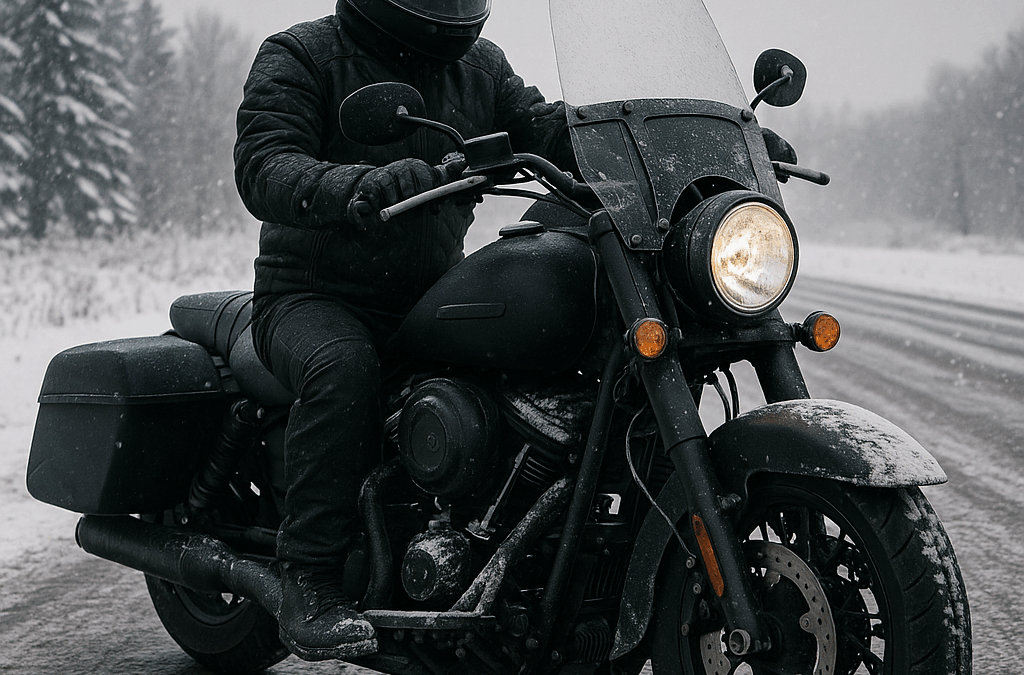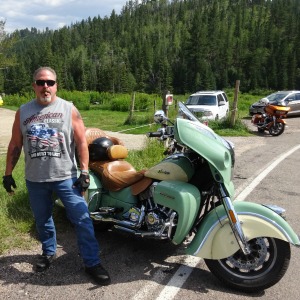By Norman Gregory Fernandez, Esq., The Biker Lawyer
As bikers, we live for the open road. There’s nothing like the feeling of two wheels beneath you, the sound of your engine, and the freedom that comes with riding—no matter the season. But as winter approaches and temperatures start dropping, many riders underestimate the dangers of cold-weather riding or overestimate their ability to “tough it out.”
Let me be blunt: riding your motorcycle in cold weather is serious business. Over the years as both a rider and a biker attorney representing injured motorcyclists throughout California and beyond, I’ve seen firsthand what happens when cold-weather riding goes wrong. Hypothermia, frostbite, delayed reaction time, numb hands—these aren’t just discomforts; they are genuine dangers that can kill you on the road.
In this article, I’m going to break down the real risks of cold-weather riding, explain why your body responds differently on a bike in low temperatures, and show you the best gear options to keep you warm, alert, and alive when the mercury drops.
The Dangers of Riding in Cold Weather
1. Hypothermia Can Happen Faster Than You Think
Most riders think of hypothermia as something that happens in snowstorms or freezing rain. Wrong. Hypothermia occurs anytime your body loses heat faster than it can replace it—and at highway speeds, this can happen in temperatures as high as 50°F.
Wind chill is the big killer here.
For example:
-
At 50°F, riding at 60 mph, the wind chill feels like 43°F.
-
At 40°F, the wind chill at the same speed drops into the low 30s or below.
Once your core body temperature drops, your ability to think clearly and physically react deteriorates rapidly. As a personal injury lawyer, I’ve represented riders who didn’t even realize they were hypothermic until after the crash.
2. Numb Hands and Feet = Delayed Reaction Time
Your extremities—fingers, toes, ears—lose heat first. If your hands go numb, even slightly, you immediately lose:
-
Dexterity
-
Grip strength
-
Precision control
-
Ability to brake quickly
-
Ability to clutch or throttle smoothly
This is a recipe for disaster. A fraction of a second delay can be the difference between avoiding a collision and becoming another statistic.
3. Cold Tires Mean Less Traction
Rubber gets harder in cold temperatures, which means:
-
Longer warm-up time
-
Less stickiness
-
Reduced cornering grip
-
Increased risk of slips and skids
Cold pavement + cold tires = bad combination.
4. Fogging Visors = Reduced Visibility
Your warm breath inside your helmet hits the cold visor and fogs instantly.
Low visibility is one of the top winter riding hazards I see cited in motorcycle crash reports.
5. Black Ice – The Silent Killer
If you ride in areas where temperatures drop near or below freezing, black ice becomes a very real threat. You often won’t see it until it’s too late.
What You Should Wear: Essential Cold-Weather Riding Gear
The good news is that with the right gear, you can significantly reduce the risks and stay warm enough to ride safely and comfortably.
Below are your best options.
1. Base Layers – The Foundation of Warmth
Never underestimate the power of a good base layer. Your base layers should be:
-
Moisture-wicking
-
Tight-fitting
-
Made of Merino wool or synthetic thermal fabric
Cotton is your enemy in the cold—it traps moisture and accelerates cooling.
Recommended pieces:
-
Thermal long-sleeve top
-
Thermal leggings
-
Moisture-wicking socks
2. Mid-Layers – Insulation Against the Cold
Mid-layers keep heat close to your core.
Great choices include:
-
Fleece jackets
-
Puffer vests
-
Heated vests (battery-powered or wired into your bike)
A good heated vest is one of the smartest investments you can make. It warms your core, which keeps blood flowing to your hands and feet.
3. Outer Shell – Windproof and Waterproof
Your outer layer is your armor against wind chill.
Must-have features:
-
Windproof
-
Waterproof
-
Abrasion-resistant
-
Breathable
Motorcycle-specific jackets and pants designed for winter riding are always best. Gore-Tex, Cordura, and other weatherproof materials are ideal.
4. Heated Gloves or Glove Liners
Frozen hands are dangerous. Heated gloves or electric glove liners keep your fingers warm and functional. Many plug directly into your bike’s electrical system (just make sure your stator can handle the load).
If you’re not using heated gloves, at least use:
-
Thick insulated gloves
-
Windproof covers
-
Handguards (if your bike allows them)
5. Neck Gaiters, Balaclavas, and Wind Stoppers
Your neck and chin are exposed areas where heat can escape fast.
Use:
-
A thermal balaclava
-
A windproof gaiter
-
Helmet skirts to keep cold air from blowing up into your helmet
6. Cold-Weather Helmets
Some helmets come with features specifically for winter, such as:
-
Pinlock anti-fog inserts
-
Breath guards
-
Better ventilation control
-
Double-pane visors (like heated snowmobile visors)
Fog-free visibility is essential in cold-weather riding.
7. Insulated or Heated Riding Boots
Feet get cold faster than almost any part of your body.
Consider:
-
Waterproof insulated riding boots
-
Heated insoles
-
Wool riding socks
8. Motorcycle Add-Ons That Help Immensely
You can upgrade your bike to make it more winter-friendly:
-
Heated grips
-
Heated seats
-
Windscreens
-
Handguards
-
Lower fairings
These upgrades can dramatically extend your cold-weather riding comfort.
Final Thoughts: Ride Smart or Don’t Ride
Cold-weather riding requires preparation, awareness, and respect for the elements. Riding without proper gear isn’t just uncomfortable—it’s dangerous. Your reaction time decreases, your body stiffens, and hypothermia can hit before you realize anything is wrong.
As “The Biker Lawyer,” I’ve represented countless injured riders. Many of those collisions could have been avoided with the right cold-weather attire and awareness of winter hazards. Riding is a passion—but staying alive and uninjured must always come first.
Gear up properly. Know your limits. Know your environment. And above all—ride safe.
If you or a loved one has been involved in a motorcycle accident, especially during cold-weather conditions, feel free to contact me. I am always here to help fellow riders.
— Norman Gregory Fernandez, Esq.
The Biker Lawyer
https://bikerlawblog.com





 Welcome, my name is
Welcome, my name is 






